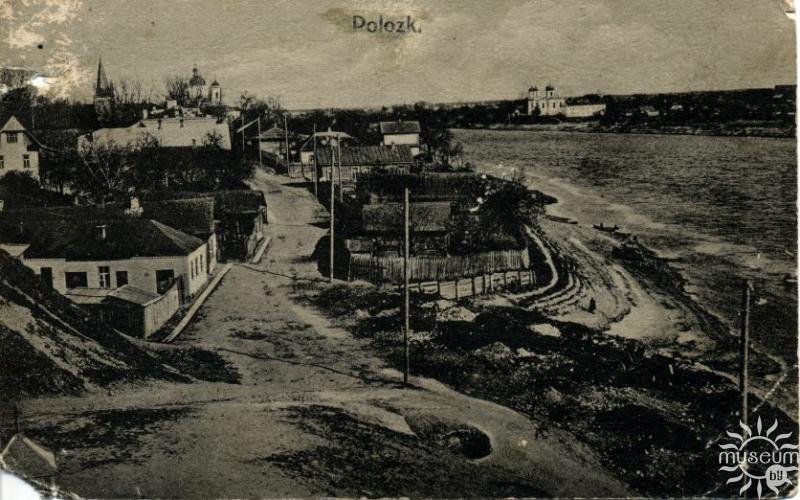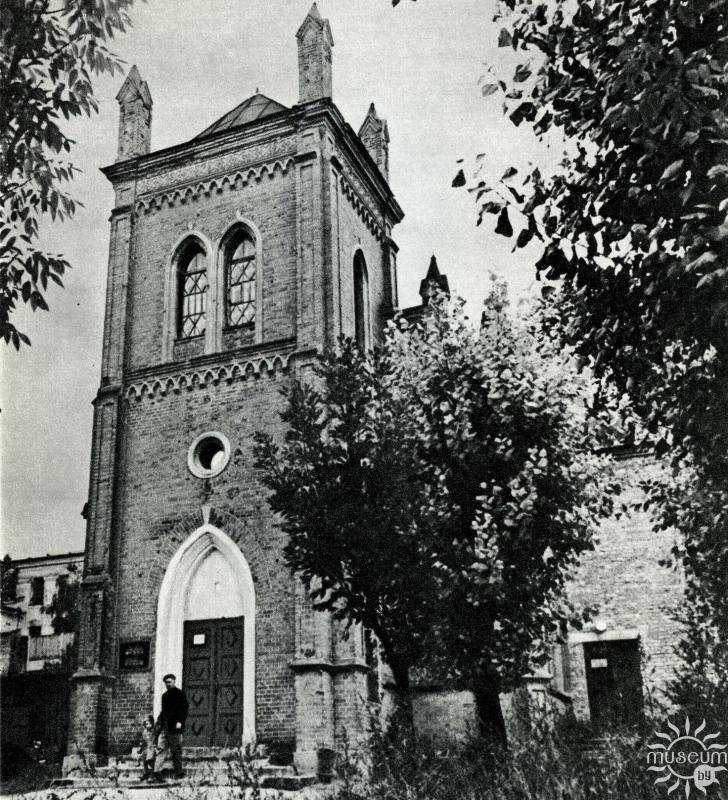
Panorama of the development of the right bank of the Western Dvina (postcard of the late 19 — early 20 centuries)

Development of Nizhne-Pokrovskaya St., view from the Upper Castle (postcard of the late 19 — early 20 centuries)

The building of the former Lutheran church
Nizhne-Pokrovskaya Street is one of the oldest streets in Polotsk. Historical sources confirm its existence already in the second half of the 11th — beginning of the 12th century. From the 13th century the street was densely populated, served as one of the main streets in the city, it was crossed by the Dvina River to the city markets, churches, synagogues, Catholic and Orthodox monasteries were located on it, the richest and most influential citizens lived there.
The first known name of this street was Velikaya Street. In the last quarter of the 18th century (in connection with the construction of St. Pokrovskaya Church) it was renamed into Nizhne-Pokrovskaya Street, in 1919 — into Lenin Street, and in 2008 the street again returned the name Nizhne-Pokrovskaya. It received its current direction in accordance with the classicist plan of Polotsk developed and approved in the late 18th century, which gave the layout of the historical center of the city the features of regularity.
The Lutheran church (house No. 11 on Nizhne-Pokrovskaya Street) was built in 1888. This unusually beautiful red brick building is a wonderful monument of Neo-Gothic architecture of the late 19th — early 20th century, which is characterized by the extensive use of medieval Gothic architecture (lancet windows and arches, richly decorated elongated gables, turrets, spires, stained glass, etc.).
The appearance of the stone Lutheran church in Polotsk at the end of the 19th century was not accidental. At that period the number of believers who were part of the Evangelist-Lutheran community in the town and the district was 850 people. The Lutherans in Polotsk lacked premises for conducting church services, the old wooden prayer house (which had existed since the late 40s of the 19th century) did not meet the needs of the time. The result of the appeal of the Department of Foreign Religion to the Vitebsk governor was the construction of a stone church on Nizhne-Pokrovskaya Street, which was inaugurated and consecrated in the name of the Saint Mary on December 18, 1888. Historical documents have preserved the name of the Polotsk Lutheran priest of the early 20th century — Felix Bertsche, whose house, incidentally, was also located on Nizhne-Pokrovskaya Street opposite the church.
After the October Revolution in 1924 the Lutheran church was closed, in 1937 its building housed the city Local History Museum, since 1938 — the district one. During the Great Patriotic War the museum was looted, and in the church, according to some information, services were restored. In the post-war period the building was used as a city cinema (1947-1948), then it was used as a granary, and only in 1950 after major repairs the exposition of the Museum of Local Studies was again located in the church, which works here until today.
According to the Resolution of the Council of Ministers of the Republic of Belarus No. 578 of 14.05.2007, the building of the former Lutheran church was included in the State List of Historical and Cultural Heritage of the Republic of Belarus.
